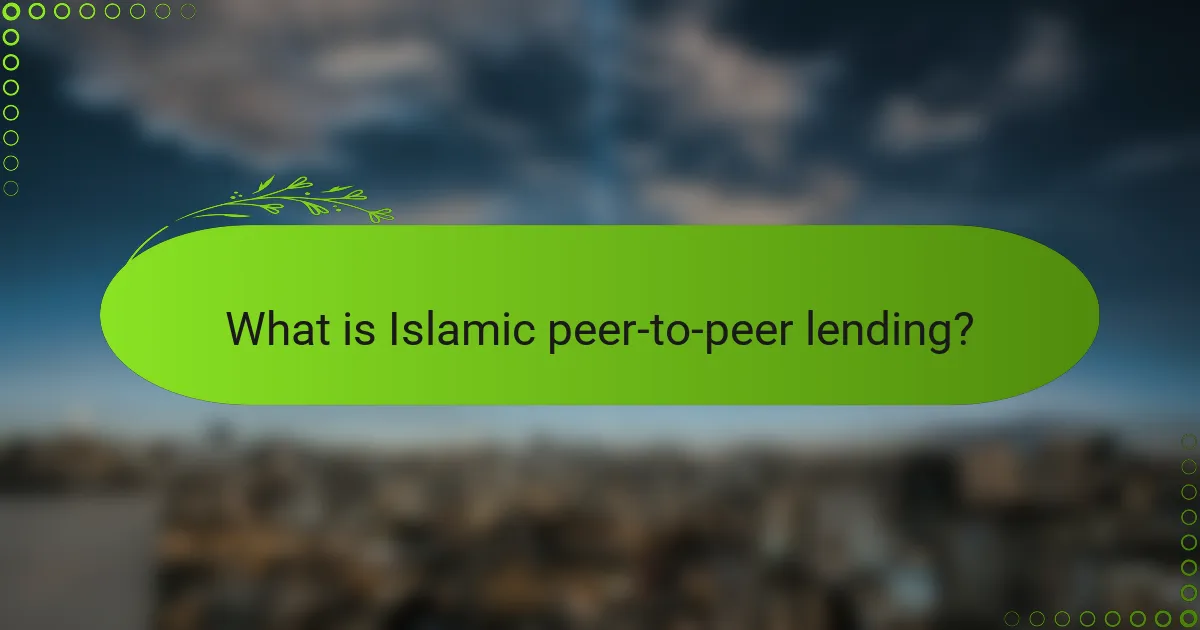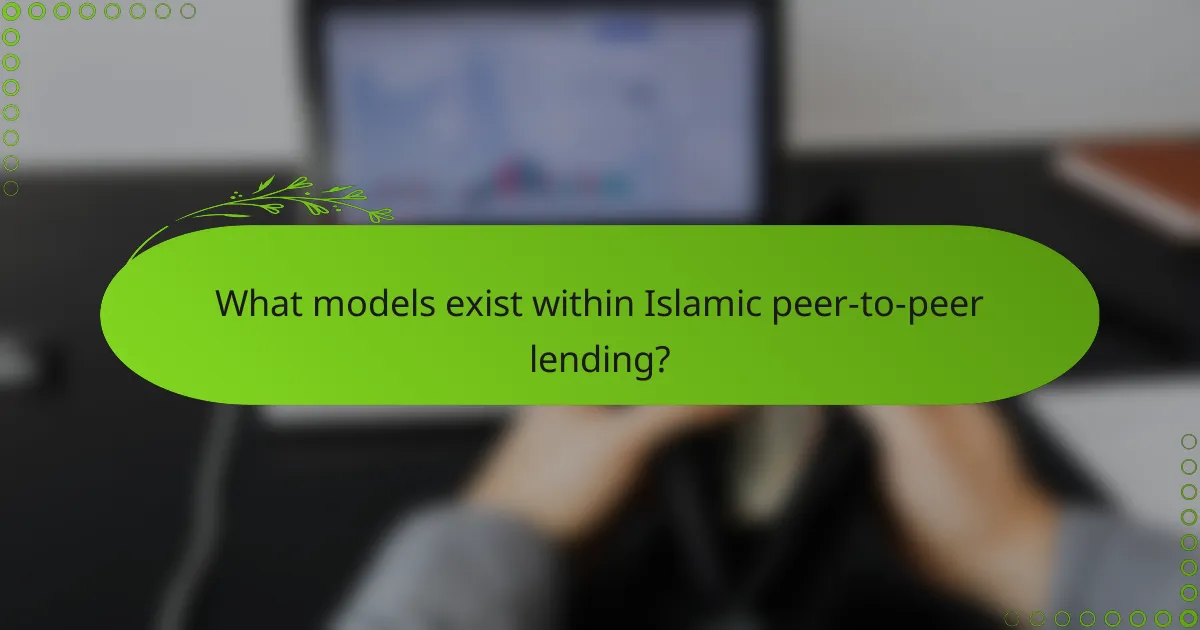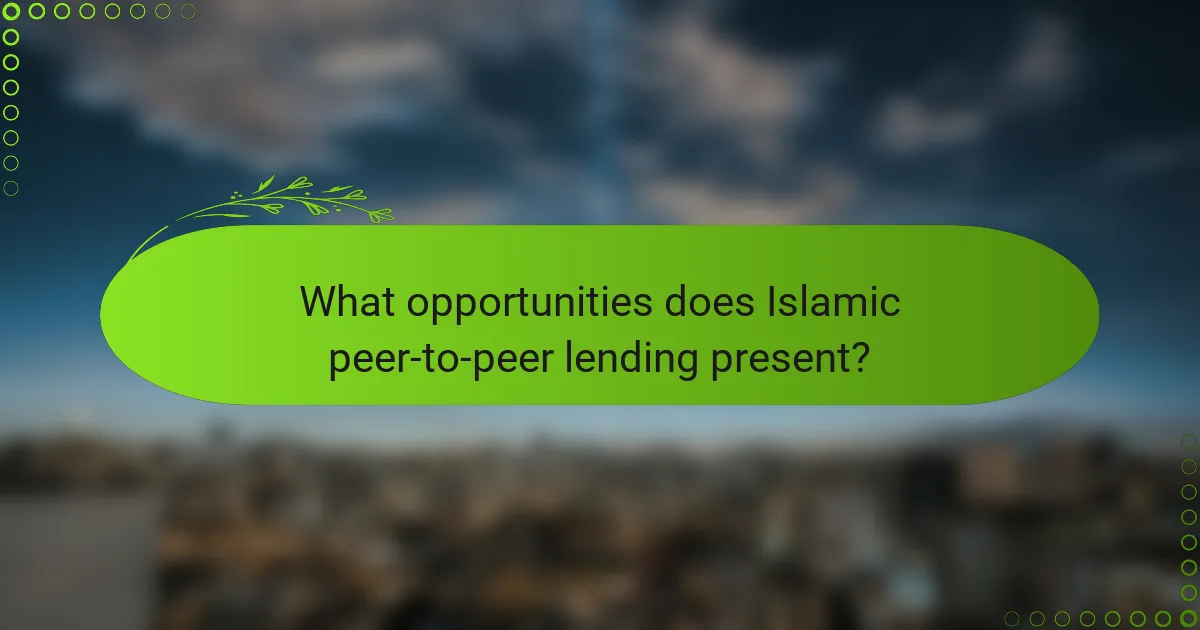
What is Islamic peer-to-peer lending?
Islamic peer-to-peer lending is a financial model that allows individuals to lend and borrow money directly from each other, adhering to Islamic principles. This model prohibits interest (riba), ensuring that transactions are based on profit-sharing or risk-sharing agreements. In Islamic peer-to-peer lending, lenders earn returns through equity participation or profit-sharing rather than charging interest. This system promotes ethical financing, aligning with Sharia law, which emphasizes fairness and social justice. The platform typically facilitates the matching of lenders and borrowers, ensuring compliance with Islamic finance principles. As of 2021, the global Islamic finance industry, including peer-to-peer lending, was valued at over $2 trillion, highlighting its growing significance.
How does Islamic peer-to-peer lending differ from traditional lending?
Islamic peer-to-peer lending differs from traditional lending primarily in its adherence to Sharia law. Traditional lending typically involves interest-based transactions, which are prohibited in Islamic finance. Instead, Islamic peer-to-peer lending operates on profit-sharing or risk-sharing principles. In this model, lenders and borrowers engage in partnerships rather than creditor-debtor relationships.
Islamic lending structures often include contracts like Murabaha or Mudarabah. These contracts define how profits are generated and shared. Traditional lending does not require such contractual clarity in profit-sharing. Additionally, Islamic peer-to-peer lending emphasizes ethical investments, avoiding industries like alcohol or gambling. This ethical focus is not a requirement in traditional lending practices.
Moreover, Islamic peer-to-peer platforms typically include community involvement in decision-making processes. Traditional lending often centralizes authority in financial institutions. This participatory approach aligns with Islamic principles of fairness and justice in financial dealings. Overall, the fundamental differences lie in the prohibition of interest, ethical considerations, and the nature of financial relationships.
What principles govern Islamic finance in peer-to-peer lending?
Islamic finance in peer-to-peer lending is governed by principles such as the prohibition of riba (interest), gharar (excessive uncertainty), and the requirement for ethical investments. Riba forbids earning income from money lending. Gharar prohibits transactions with excessive uncertainty or ambiguity. Ethical investments ensure that the funds are used for socially responsible projects. These principles align with Sharia law, promoting fairness and transparency in financial transactions. Compliance with these principles is essential for legitimacy in Islamic finance practices.
What are the key features of Islamic peer-to-peer lending platforms?
Islamic peer-to-peer lending platforms feature compliance with Sharia law. They prohibit interest (riba) and promote profit-sharing models. These platforms often utilize risk-sharing mechanisms. They may include partnerships (mudarabah) or joint ventures (musharakah). Transparency in transactions is emphasized to ensure ethical practices. Due diligence on borrowers is conducted to assess creditworthiness. Many platforms provide social impact assessments. They aim to support underserved communities and promote financial inclusion.
What are the benefits of Islamic peer-to-peer lending?
Islamic peer-to-peer lending offers several benefits. It promotes risk-sharing instead of risk transfer. This aligns with Islamic finance principles that discourage interest (riba). Participants can earn profit through equity participation rather than fixed interest rates. It fosters financial inclusion by providing access to capital for underbanked individuals. The model encourages community support and social responsibility. Additionally, it can lead to lower borrowing costs due to reduced overhead. Islamic peer-to-peer lending platforms often emphasize transparency in transactions. Studies show that ethical investment practices can enhance trust among participants, leading to increased participation.
How does Islamic peer-to-peer lending promote financial inclusion?
Islamic peer-to-peer lending promotes financial inclusion by providing access to financing for individuals and small businesses that are often excluded from traditional banking systems. This model operates without interest, adhering to Sharia law, which attracts a wider audience, including those who avoid conventional loans due to religious beliefs. It facilitates direct connections between lenders and borrowers, reducing reliance on intermediaries and lowering costs.
Additionally, Islamic peer-to-peer lending platforms often utilize technology to streamline the borrowing process. They assess creditworthiness using alternative data, which can include social and behavioral factors, allowing for a more inclusive evaluation. This method enables underserved populations to gain access to capital, fostering entrepreneurship and economic growth.
According to a report by the World Bank, such inclusive financial practices can significantly enhance the economic participation of marginalized groups. This demonstrates the effectiveness of Islamic peer-to-peer lending in promoting financial inclusion.
What are the ethical advantages of Islamic peer-to-peer lending?
Islamic peer-to-peer lending offers several ethical advantages. It adheres to Sharia law, which prohibits interest (riba). This creates a fairer system, as profit-sharing replaces exploitative interest rates. Participants engage in risk-sharing, promoting mutual benefit and partnership. The model encourages social responsibility and community support. Investments are directed towards socially beneficial projects. This aligns financial activities with ethical values. Islamic peer-to-peer lending fosters financial inclusion for underserved populations. It also enhances transparency in transactions, reducing the potential for fraud.

What models exist within Islamic peer-to-peer lending?
Islamic peer-to-peer lending primarily consists of two models: the Murabaha model and the Mudarabah model. The Murabaha model involves a sale agreement where the lender purchases an asset and sells it to the borrower at a markup. This model ensures that the transaction complies with Islamic finance principles by avoiding interest.
The Mudarabah model is a profit-sharing agreement. In this model, one party provides the capital while the other party manages the investment. Profits are shared according to a pre-agreed ratio, while losses are borne by the capital provider. Both models adhere to Shariah law, prohibiting interest and promoting ethical investment practices.
What are the primary models of Islamic peer-to-peer lending?
The primary models of Islamic peer-to-peer lending include Murabaha, Ijara, and Qard Hasan. Murabaha involves the lender purchasing an asset and selling it to the borrower at a profit margin. Ijara is a lease-to-own model where the lender retains ownership of the asset while the borrower makes rental payments. Qard Hasan is a benevolent loan model where the lender provides funds without expecting any profit. These models adhere to Islamic finance principles, avoiding interest (riba) and promoting ethical investment. Each model serves different financial needs while ensuring compliance with Sharia law.
How does the profit-sharing model work in Islamic peer-to-peer lending?
The profit-sharing model in Islamic peer-to-peer lending operates on the principles of profit and loss sharing. In this model, investors provide capital to borrowers, and they share the profits generated from the use of that capital. The profit-sharing ratio is agreed upon in advance, ensuring transparency and fairness.
This model avoids interest, which is prohibited in Islamic finance. Instead, it aligns the interests of both parties. Borrowers benefit from access to funds, while investors receive returns based on the profits earned. This creates a partnership-like relationship.
For example, if a borrower uses the funds to start a business, profits from that business are shared according to the pre-defined agreement. This structure promotes ethical lending practices and encourages responsible borrowing. The model is designed to foster economic growth while adhering to Islamic principles.
What role does the murabaha model play in Islamic peer-to-peer lending?
The murabaha model serves as a financing mechanism in Islamic peer-to-peer lending. It allows lenders to provide capital for purchasing goods or services. In this model, the lender buys the asset and sells it to the borrower at a marked-up price. The borrower then repays this amount in installments. This structure complies with Islamic law, which prohibits interest (riba). Murabaha ensures transparency in transactions, as the profit margin is disclosed upfront. This model promotes ethical financing by aligning with Islamic principles. It also mitigates risks for both parties involved, fostering trust and cooperation.
How do these models impact borrowers and lenders?
Islamic peer-to-peer lending models impact borrowers and lenders by promoting ethical financing practices. Borrowers benefit from interest-free loans, which align with Islamic principles. This model reduces the financial burden on borrowers, allowing them to repay loans without accruing additional costs. Lenders, on the other hand, engage in profit-sharing arrangements. This creates a sense of partnership between lenders and borrowers. Such models encourage responsible lending and borrowing behaviors. They also foster community support and financial inclusion. Studies show that ethical lending practices can lead to higher repayment rates. Overall, these models create a balanced ecosystem that benefits both parties.
What are the risks associated with each model?
Islamic peer-to-peer lending models carry various risks. Each model presents unique challenges. One risk is regulatory uncertainty. Compliance with Islamic law can be complex. This can lead to legal complications. Another risk is credit risk. Borrowers may default on repayments. This poses a financial loss to lenders. Additionally, operational risk exists. Mismanagement of funds can impact returns. Market risk is also a concern. Economic downturns can affect borrower repayment ability. Lastly, reputational risk can arise. Negative public perception can harm the platform’s credibility. These risks must be carefully managed to ensure success in Islamic peer-to-peer lending.
How do the models affect the returns for lenders?
Models in Islamic peer-to-peer lending directly influence the returns for lenders. Different models determine the risk-sharing and profit-sharing mechanisms. For instance, the profit and loss sharing model allows lenders to earn returns based on the actual performance of the financed project. This can lead to higher returns if the project succeeds. Conversely, fixed-rate models provide predictable returns but may limit potential gains. The choice of model affects the risk exposure and expected profitability for lenders. Research indicates that lenders using risk-sharing models can experience variable returns, which may be higher than traditional lending methods. This variability reflects the underlying project’s success and market conditions.

What risks are associated with Islamic peer-to-peer lending?
Islamic peer-to-peer lending carries several risks. Default risk occurs when borrowers fail to repay loans. This can lead to financial losses for lenders. Regulatory risk involves changes in laws that may affect the lending framework. Such changes can impact operational viability. Market risk is present due to fluctuating economic conditions that may influence borrower repayment capabilities. Additionally, there is a risk of fraud, where dishonest parties may misrepresent their financial status. Lastly, liquidity risk arises if lenders cannot easily convert their investments into cash. These risks highlight the importance of thorough due diligence in Islamic peer-to-peer lending.
What are the common risks faced by participants in Islamic peer-to-peer lending?
Participants in Islamic peer-to-peer lending face several common risks. These risks include credit risk, where borrowers may default on their repayments. The lack of a credit history can make it difficult to assess borrower reliability. Market risk is another concern, as economic fluctuations can affect borrowers’ ability to repay. Regulatory risk exists due to changes in laws governing Islamic finance. Additionally, operational risk can arise from technical failures in the lending platform. Lastly, liquidity risk may occur if participants cannot easily access their invested funds. Each of these risks can impact the overall success of Islamic peer-to-peer lending ventures.
How can borrowers mitigate risks in Islamic peer-to-peer lending?
Borrowers can mitigate risks in Islamic peer-to-peer lending by conducting thorough due diligence on potential lenders. This involves reviewing the lender’s credentials, past performance, and feedback from other borrowers. Borrowers should also ensure compliance with Shariah principles to avoid any prohibited activities, which can lead to financial loss. Utilizing platforms that provide transparent information about loan terms and conditions is crucial. Additionally, borrowers can diversify their funding sources to reduce reliance on a single lender. Maintaining clear communication with lenders can help in addressing any issues promptly. Establishing a solid repayment plan is essential to manage financial obligations effectively. Lastly, borrowers should be aware of the legal framework governing Islamic lending to protect their rights.
What strategies can lenders use to minimize their risks?
Lenders can minimize their risks by implementing thorough credit assessments. This involves evaluating borrowers’ credit histories and financial stability. Lenders should also diversify their loan portfolios. This reduces exposure to any single borrower or sector. Establishing clear lending criteria is essential. It helps in selecting borrowers who meet specific financial requirements.
Utilizing risk-based pricing is another effective strategy. This approach adjusts interest rates based on the assessed risk level of borrowers. Lenders can also require collateral for loans. Collateral provides security and reduces potential losses. Regular monitoring of borrowers’ financial health is crucial. This allows lenders to identify potential issues early.
Lastly, lenders can engage in partnerships with experienced platforms. These partnerships can provide additional insights and risk management tools. By employing these strategies, lenders can effectively reduce their overall risk exposure.
What regulatory challenges exist for Islamic peer-to-peer lending?
Islamic peer-to-peer lending faces several regulatory challenges. One major challenge is the lack of clear regulatory frameworks in many jurisdictions. This ambiguity can lead to uncertainty for both lenders and borrowers. Additionally, compliance with Sharia law complicates the regulatory landscape. Traditional financial regulations may not align with Islamic principles, creating conflicts. There is also the challenge of consumer protection. Ensuring that borrowers are informed and safeguarded is essential, yet often inadequately addressed. Furthermore, the need for licensing and registration varies widely across regions. This inconsistency can hinder the growth of Islamic peer-to-peer lending platforms. Lastly, issues related to anti-money laundering (AML) and counter-terrorism financing (CTF) regulations are significant. These regulations require strict adherence, which can be burdensome for startups in this sector.
How do regulations vary across different countries?
Regulations for Islamic peer-to-peer lending vary significantly across different countries. In some countries, such as Malaysia and Indonesia, specific regulations support Islamic finance models. These regulations often include guidelines for Sharia compliance and consumer protection. In contrast, countries like the United States and the United Kingdom have more general financial regulations that may not specifically address Islamic lending practices. The lack of tailored regulations in these regions can create challenges for Islamic peer-to-peer lending platforms. Furthermore, countries in the Middle East tend to have robust frameworks supporting Islamic finance, promoting the growth of peer-to-peer lending. Overall, the regulatory environment plays a crucial role in shaping the landscape for Islamic peer-to-peer lending globally.
What impact do regulations have on the growth of Islamic peer-to-peer lending?
Regulations significantly impact the growth of Islamic peer-to-peer lending. They establish a framework that ensures compliance with Sharia principles. This compliance fosters trust among investors and borrowers. Trust is essential for participation in Islamic finance. Regulations can also enhance transparency in transactions. Transparency helps mitigate risks associated with lending. Additionally, supportive regulations can encourage innovation in financial products. Countries with clear regulatory guidelines often see higher growth rates in Islamic peer-to-peer lending. For example, Malaysia’s regulatory framework has led to a robust Islamic finance sector.

What opportunities does Islamic peer-to-peer lending present?
Islamic peer-to-peer lending presents opportunities for ethical financing and financial inclusion. It allows individuals to invest in Sharia-compliant projects while earning returns. This model fosters community support by connecting borrowers with lenders directly. It also reduces reliance on traditional banks, which may not align with Islamic principles. The market for Islamic finance is growing, with estimates indicating a potential worth of $3 trillion. This growth opens avenues for innovation in financial products. Additionally, it encourages responsible lending practices by promoting transparency and fairness. Overall, Islamic peer-to-peer lending creates a sustainable financial ecosystem that benefits all participants.
How can Islamic peer-to-peer lending contribute to economic development?
Islamic peer-to-peer lending can contribute to economic development by providing accessible financing to underserved populations. This model operates without interest, adhering to Sharia principles, which promotes ethical financial practices. It enables individuals and small businesses to obtain funds that traditional banks may deny due to high-risk assessments.
Research indicates that Islamic finance, including peer-to-peer lending, can enhance financial inclusion. According to a report by the Islamic Financial Services Board, the global Islamic finance market has seen significant growth, reaching over $2.9 trillion in assets in 2021. This expansion creates opportunities for economic growth in developing regions.
Furthermore, Islamic peer-to-peer lending fosters entrepreneurship. By facilitating access to capital, it empowers individuals to start or expand businesses, leading to job creation. A study published in the Journal of Economic Studies found that microfinance initiatives, including peer-to-peer lending, significantly boost local economies by increasing employment rates.
Overall, Islamic peer-to-peer lending serves as a vital tool for economic development by promoting financial inclusion, supporting entrepreneurship, and adhering to ethical financing principles.
What role does technology play in enhancing Islamic peer-to-peer lending opportunities?
Technology significantly enhances Islamic peer-to-peer lending opportunities by improving accessibility and efficiency. Digital platforms facilitate connections between lenders and borrowers, streamlining the lending process. Mobile applications allow users to engage in transactions anytime and anywhere, increasing participation. Blockchain technology ensures transparency and security in transactions, fostering trust among users. Data analytics helps assess creditworthiness, enabling informed lending decisions. These advancements contribute to a more inclusive financial ecosystem, particularly for underserved communities. The rise of fintech companies specializing in Islamic finance demonstrates the growing integration of technology in this sector.
How can Islamic peer-to-peer lending support small businesses?
Islamic peer-to-peer lending can support small businesses by providing interest-free financing options. This model aligns with Sharia principles, which prohibit riba (interest). Small businesses can access funds without incurring debt burdens. It fosters community investment, allowing individuals to support local enterprises.
According to a report by the Islamic Finance Council UK, peer-to-peer lending can enhance financial inclusion. This is crucial for small businesses often excluded from traditional banking. The model encourages risk-sharing between lenders and borrowers. It can lead to sustainable growth for small enterprises.
In 2020, the global Islamic finance market was valued at approximately $2.88 trillion, indicating significant potential for peer-to-peer lending. This growth can empower small businesses, driving economic development in various communities.
What are the best practices for engaging in Islamic peer-to-peer lending?
The best practices for engaging in Islamic peer-to-peer lending include ensuring compliance with Shariah principles. Participants should avoid interest (riba) and excessive uncertainty (gharar). Clear contracts outlining terms are essential for transparency. All parties must agree on profit-sharing ratios. Due diligence on borrowers is crucial to assess creditworthiness. Utilizing reputable platforms that adhere to Islamic guidelines enhances trust. Regular communication between lenders and borrowers fosters a positive relationship. Monitoring the investment performance helps manage risks effectively.
What should borrowers consider before participating in Islamic peer-to-peer lending?
Borrowers should consider the compliance of Islamic peer-to-peer lending with Sharia law. This includes understanding the prohibition of interest (riba) and ensuring that the lending model does not involve any unethical practices. Borrowers must also evaluate the risks associated with peer-to-peer lending, such as the potential for borrower defaults. Additionally, assessing the platform’s credibility and regulatory compliance is crucial for security. Borrowers should also review the terms of the agreement, including repayment schedules and fees. Transparency in the lending process is important for informed decision-making. Lastly, borrowers should consider their financial capability to meet repayment obligations without compromising their financial stability.
What tips can lenders follow to ensure successful investments in Islamic peer-to-peer lending?
Lenders can ensure successful investments in Islamic peer-to-peer lending by conducting thorough due diligence. This involves evaluating the creditworthiness of borrowers and understanding their repayment capacity. Lenders should also diversify their investment portfolio to mitigate risks. By spreading investments across various projects, lenders can reduce potential losses.
Additionally, lenders must ensure compliance with Shariah principles. This includes avoiding interest-based financing and ensuring transparency in all transactions. Engaging with reputable platforms that adhere to these principles is crucial.
Monitoring investments regularly helps lenders stay informed about performance and market trends. Keeping track of borrower communications can also provide insights into repayment behaviors. By following these tips, lenders can enhance their chances of success in Islamic peer-to-peer lending.
Islamic peer-to-peer lending is a financial model that enables individuals to lend and borrow money directly while adhering to Islamic principles, specifically prohibiting interest (riba). This article explores the various models of Islamic peer-to-peer lending, such as Murabaha and Mudarabah, and outlines the risks associated with these models, including credit and regulatory risks. Additionally, it highlights the ethical advantages, benefits for financial inclusion, and the role of technology in enhancing lending opportunities. The discussion emphasizes how Islamic peer-to-peer lending can support small businesses and contribute to economic development, providing insights into best practices for both borrowers and lenders.